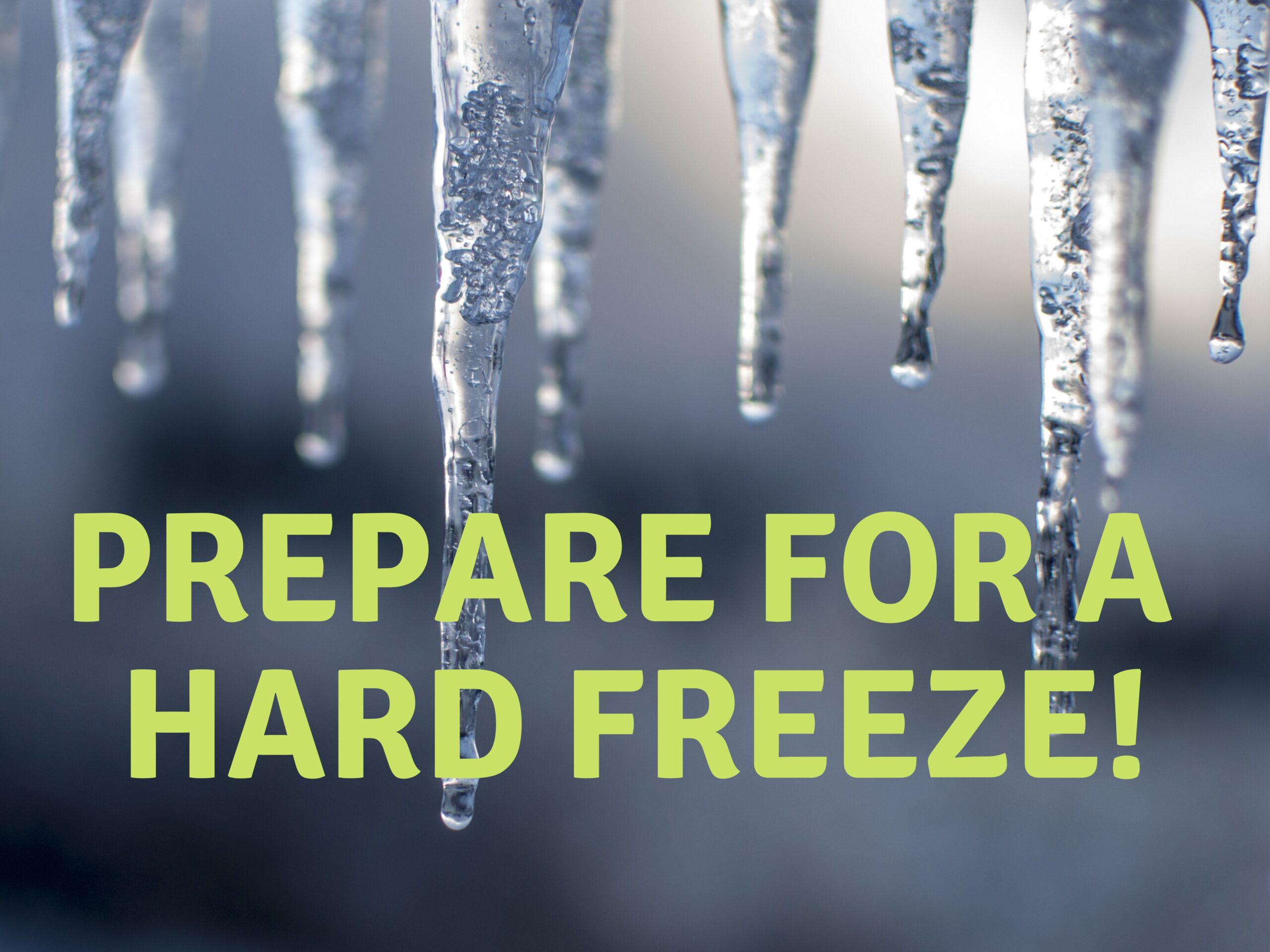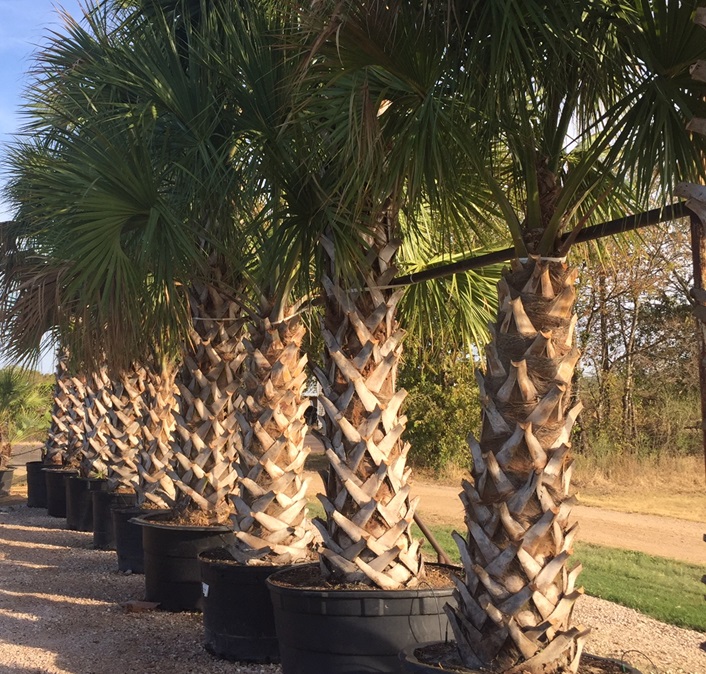If you are reading this now, it is likely that a “freak” winter event is on its way. Central Texas is known for its variable weather patterns and wide swings in temperature are not unheard of. Weather prediction in Central Texas is difficult, so I would suggest that we prepare for the worst and hope for the best in any predicted extreme event. We are seeing forecast lows of anywhere from 10°F to 15°F for much of our area, with below freezing temperatures lasting up to 60 hours or more in some areas. Valleys will typically drop lower than higher areas.
We must do our best to protect plants during this event. Here are some guidelines to help with winter protection.
Vegetable Gardens:
Harvest everything that you can use before the freeze.
Water the soil at least a day before the freeze is expected.
Mulch the rest with compost, straw, leaves, hardwood mulch, newspaper or cardboard covered with mulch or whatever insulative material that is available to a depth of 2″-3″. Fabric, such as frost fabric, blankets, comforters, sheets, etc. may be used but may have to have frame built over the more delicate plants so they are not crushed. Plastic may be used ONLY if ON TOP of the fabric or mulch, and should never touch the plants. Plastic MUST be removed when temperatures reach 30°F or heat buildup may damage the plants. NEVER PLACE PLASTIC DIRECTLY ON PLANTS AND DO NOT LEAVE ON WHEN TEMPERATURES ARE ABOVE 30°F.
Remember, the ground holds heat that will need to be captured, so anchor the fabric to the ground with bricks or other heavy objects.
Ornamentals:
Many of the ornamentals that normally survive a winter in our area will be damaged or killed by the sustained low temperatures that we are expecting. Plan to cover these plants with layers of frost cloth as well as possible, anchoring it to the ground to capture ground heat. Apply 2″-3″ of mulch to the soil around the plants to insulate the root system. If they do die back to the ground you will have a chance that they will come back from the roots. As always, water the soil BEFORE the freeze. Here are some of the plants that will need protection:
Indian Hawthorne Sago Palm Agave
Confederate Jasmine Butterfly Vine Bottlebrush
Loquat Camellia Texas Sage
Desert Museum Fig Trees Jap. Yew
Loropetalum Oleander Olive trees
Pineapple Guava Viburnum Thryallis
Pride of Barbados Esperanza Mex. Firebush
Palms
Even established, winter-hardy palms may be damaged by sustained low temperatures. Unfortunately, it is difficult to protect the growing point of the taller palms from freezing. If this area that is at the base of the “spear leaf” freezes and dies, your palm will not come back. If you can reach the top fronds and bundle them together around the “spear leaf”, you can then wrap the area with the growing tip (apical meristem) with frost fabric. burlap, or other fabric material to help insulate the area. Christmas tree lights (ones that generate heat) have been used to provide added heat to the area. DO NOT LEAVE THE WRAP OR LIGHTS ON ANY LONGER THAN NECESSARY. Remove the protection when the freeze is past to avoid rotting the growing tip or trunk.
With the extreme lows expected in some of our area it would also be wise to wrap the trunks with layers of frost fabric, burlap or other fabric material. DO NOT LEAVE THIS ON LONGER THAN NECESSARY FOR THE FREEZING TEMPERATURES.
Apply 2″-3″ of mulch around the palm to insulate the roots. Water the roots at least a day before the freeze.
Tropicals, Citrus and All Plants in Pots
Plants in pots, regardless of winter hardiness, will need to be protected from this winter event. Move all potted plants inside if possible. If your garage is likely to freeze, move the plants inside your house. Click HERE for some additional suggestions for protecting Tropical Plants in the winter.
If you have absolutely nowhere to bring potted plants inside, here is one way that I have been able to save some of mine in the past. Move the pots to the Southeast or Southwest corner of the house, as it is the most protected from the Northwest winter winds. Water the soil well. Lay the potted plants down on their sides, overlapping them and placing them close together to take advantage of capturing the ground heat before you cover them. Use multiple layers of frost cloth, burlap, sheets, comforters or anything but plastic. Anchor the covering to the ground. At least now your plants have a chance. Remove the covering when danger of freeze is past and inspect for damage. You may have to cut the plants back, but hopefully the roots will have been saved.
Herbaceous and Evergreen Perennials
Herbaceous perennials are those that naturally die back to the ground when it freezes. Some are more root-hardy than others, so be sure to mulch and water them before any freeze. This will give them the best chance possible. Tender perennials such as Pride of Barbados or Esperanza will have a better chance of coming back if they are well-established going into the freeze. We try not to plant these in the late summer or fall for this reason. Mulch these plants VERY well.
Evergreen perennials such as Salvia greggii and Jerusalem Sage will have varying degrees of cold hardiness. Water the soil around them and be sure they are mulched. If they are not well-established, a couple layers of frost fabric may help. We will wait until spring to evaluate any damage.
NOTE: We do not recommend cutting back woody perennials such as Lantana that have gone dormant until late February. The growth left on top will insulate the crown of the plants and the roots from hard freezes. Ornamental grasses should also be left for this reason. Resist the urge to cut back plants too early in the fall or winter. They will have a better chance of survival.





Do newly planted fruit trees need protection (apple, pear, peach)? I know figs do.
Water well and apply 2″-3″ of mulch around the planting area. Do not allow the mulch to touch the trunk. I think our biggest challenge is that our area did not have much of the gradual cooling of temperatures this winter. Yesterday was 73°F! These variable temps create additional issues. You could wrap the trunks above the graft with burlap for the duration of the freeze as long as it does not get wet. I don’t know where the trees were grown before you purchased them, so I don’t know how much cold they have been exposed to. We also really don’t know how low it will go or for how long. The challenges of gardening in the Hill Country!
Our barbados is too big to cover.What do I do?
If you are asking about the Pride of Barbados, or Caesalpinia pulcherima, you are not trying to save the top. It almost always freezes back to the ground in our Zone 8, so the best thing that you can do is to try to keep the roots from freezing. Apply 2″-3″ of mulch over the root system several feet out. You do not need to cut the plant back yet. Wait until late Feb/early March to do that. The stems will help insulate the crown of the plant. Be sure the plant is watered before the freeze or at least that the soil is moist and not dry. Dry soil cools faster than wet soil. I hope this helps.
Yes,thank you so much.Stay warm!